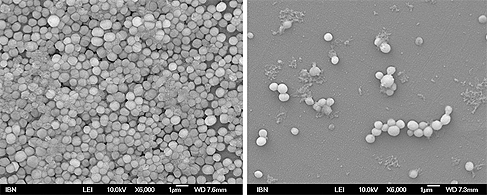The synthetic hydrogel, which forms when heated to body temperature, is said to be the first to be biodegradable, biocompatible and non-toxic, making it viable for combating health hazards facing hospital workers, visitors and patients.
IBM Research and its collaborators achieved this by developing a remouldable synthetic antimicrobial hydrogel, comprised of more than 90 per cent water, which, if commercialised, is reportedly suitable for applications such as creams or injectable therapeutics for wound healing, implant and catheter coatings, skin infections or orifice barriers.
Able to colonise on almost any tissue or surface, microbial biofilms — in this case adhesive groupings of diseased cells present in 80 per cent of all infections — persist at various sites in the human body, especially in association with medical equipment and devices. They contribute to hospital-acquired infections, which are among the top five leading causes of death in the US and account for up to $11bn in healthcare spending each year.
Through the precise tailoring of polymers, researchers designed macromolecules that combine water solubility, positive charge, and biodegradability characteristics.
When mixed with water and heated to body temperature the polymers self-assemble, swelling into a synthetic gel that is easily manipulated.
This capability stems from self-associative interactions that create a so-called ‘molecular zipper’ effect; the short segments on the new polymers interlock, thickening the water-based solution into re-mouldable and compliant hydrogels.
Since they exhibit certain characteristics of water-soluble polymers without being freely dissolved, such materials can remain in place under physiological conditions while still demonstrating anti-microbial activity.
In a statement, James Hedrick at IBM Research said: ‘This is a fundamentally different approach to fighting drug-resistant biofilms. When compared with capabilities of modern-day antibiotics and hydrogels, this new technology carries immense potential.
‘This new technology is appearing at a crucial time as traditional chemical and biological techniques for dealing with drug-resistant bacteria and infectious diseases are increasingly problematic.’
When applied to contaminated surfaces, the hydrogel’s positive charge attracts all negatively charged microbial membranes. However, unlike most antibiotics and hydrogels, which target the internal machinery of bacteria to prevent replication, this hydrogel kills bacteria by membrane disruption, precluding the emergence of any resistance.
The research was recently published in Angewandte Chemie.






Poll: Should the UK’s railways be renationalised?
I _do_ remember British Rail - and that it was <i>literally</i> a national joke https://youtu.be/zV2lmSDKvO8